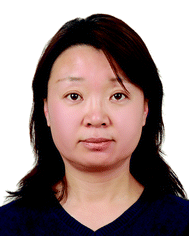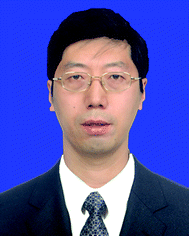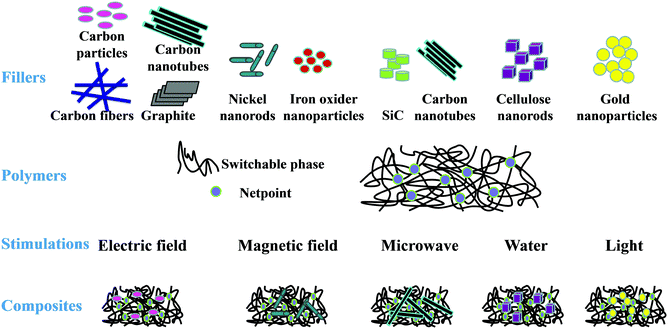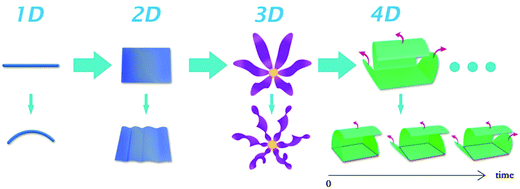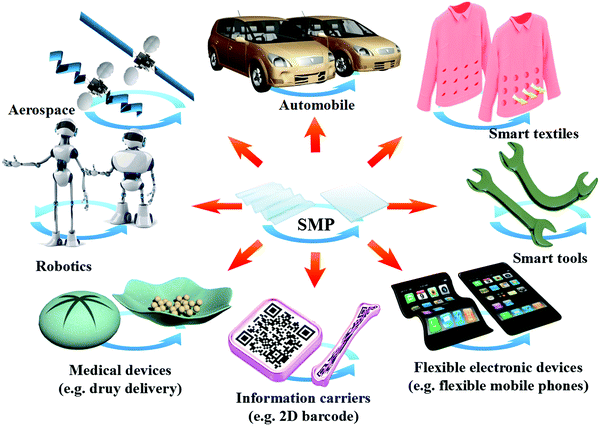Nano/microstructures of shape memory polymers: from materials to applications
Fenghua
Zhang
 a,
Yuliang
Xia
a,
Yanju
Liu
b and
Jinsong
Leng
a,
Yuliang
Xia
a,
Yanju
Liu
b and
Jinsong
Leng
 *a
*a
aNational Key Laboratory of Science and Technology on Advanced Composites in Special Enviroments, Harbin Institute of Technology (HIT), Harbin 150080, P. R. China. E-mail: lengjs@hit.edu.cn
bDepartment of Astronautical Science and Mechanics, Harbin Institute of Technology (HIT), Harbin 150001, P. R. China
First published on 2nd June 2020
Abstract
Shape memory polymers (SMPs) are macromolecules in which linear chains and crosslinking points play a key role in providing a shape memory effect. As smart polymers, SMPs have the ability to change shape, stiffness, size, and structure when exposed to external stimuli, leading to potential uses for SMPs throughout our daily lives in a diverse range of areas including the aerospace and automotive industries, robotics, biomedical engineering, smart textiles, and tactile devices. SMPs can be fabricated in many forms and sizes from the nanoscale to the macroscale, including nanofibers, nanoparticles, thin films, microfoams, and bulk devices. The introduction of nanostructure into SMPs can result in enhanced mechanical properties, unique structural color, specific surface area, and multiple functions. It is necessary to enhance the current understanding of the various nano/microstructures of SMPs and their fabrication, and to find suitable approaches for constructing SMP-based nano/microstructures for different applications. In this review, we summarize the current state of different SMP nano/microstructures, fabrication techniques, and applications, and give suggestions for their future development.
1. Introduction
Biological systems that integrate sensing, actuation, and control can serve as useful models for smart materials.1–3 For example, the plant Mimosa pudica (Fig. 1) responds to an external stimulus and converts chemical signals into mechanical action. In the animal kingdom, chameleon skin exhibits smart behavior and provides protection against attack by changing color according to the surroundings. In practice, materials scientists have been able to mimic biology and artificially produce smart materials that behave in a similar way and respond to an even broader range of stimuli.4–6Academic and industrial research on soft shape-changing materials is an active field of research that is receiving worldwide attention.7–9 Shape memory polymers (SMPs) in particular exhibit excellent characteristics, as they can respond to external stimuli,10 including heat,11 light,12 pH,13 microwaves,14 electrical and magnetic fields,15,16 water,17 pressure,18 ultrasound,19 and vapor,20 leading to changes in their shape, size, strain, or stiffness.21 Such characteristics promise numerous potential opportunities that make them of great interest to researchers, significantly promoting activity and investment in this area.
Recent advances in shape-changing materials have demonstrated the inherent potential of materials with flexible and tunable shapes,22–25 and therefore SMPs are becoming increasingly well-known and are appearing in a diverse range of applications and environments.7,23,24 High-performance loadbearing substructures of satellites, aircraft, and robots designed for structural efficiency have been developed to incorporate smart components to trigger folding, extending, and bending of components to add active functions.25–27 In the industrial sector, a multitude of important novel practical applications are being developed, including smart clothes,28 self-healing systems,29 anti-counterfeiting measures,30 information carriers,31 optical devices,32 and biomedical devices.33,34 In addition, 4D printing has been developed as a new fabrication technology, adding the extra dimension of time-dependent shape change to established 3D printing by enabling spatial variation of the material properties in each element of the printed component.35–37 SMPs are an exemplar of active shape-changing materials that have seen rapid development in recent years and have led the way in terms of the nature and variety of material properties demonstrated.7,10,38–40
Nanotechnology is an interdisciplinary and comprehensive subject, which involves a wide range of modern science and technology. The preparation and research of nanomaterials are the basis of the whole of nanotechnology. Among them, nanophysics and nanochemistry are the theoretical basis of nanotechnology. Nanotechnology focuses on the design and manufacture of nanostructures, including nanofibers, nanoconstructions, nanofoams, nanopatterns, and nanoparticles, as shown in Fig. 2. When the structure is as small as the nanoscale, it may surpass or even be different from the macroscale structure in electronics, optics, mechanics and other aspects. Controllable nano/microstructures can be used to design and optimize the properties of materials at the nano/microscale, improving the performance of SMPs in various applications. Owing to the structural diversity, the correlations between the structure and the performance are different, making SMPs more widely used. However, to the best of our knowledge, there has been no new model or theory for nanostructured SMPs yet. Finite element analysis (FEA) is an effective method to characterize nano/microstructured SMPs. The micromechanical model can be combined with other models to further extend the description of polymers with nano/microstructures. It is no exaggeration to say that the introduction of stimulus-responsive materials with controllable nano/microstructures has brought about a revolution in the area of active materials. The integration of controllable nano/microstructures into one material is expected to broaden the application base for soft smart materials and structures, and offers insight into the future directions for smart devices and similar products.41–44
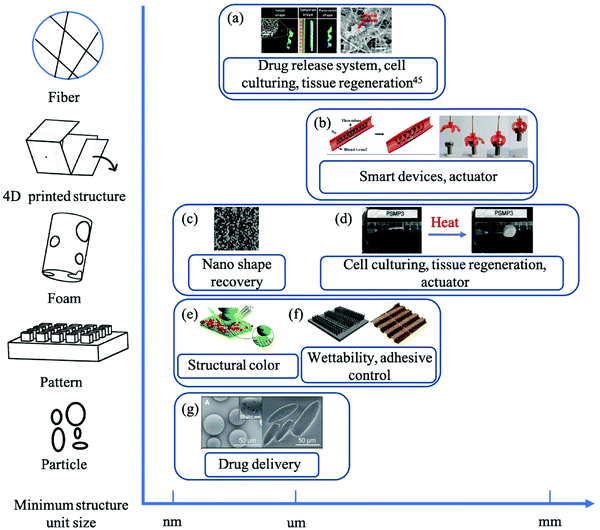 | ||
| Fig. 2 SMPs with microstructure. (a) Electrospun nanofiber shape recovery process. Reproduced with permission.45 Copyright 2014, American Chemical Society. (b) 4D printed SMP shape recovery process. Reproduced with permission.46,47 Published under a CC-BY 4.0 license. Copyright 2016, the authors. Copyright 2017, American Chemical Society. (c) AFM topography images of the porous PGMA film, and shape recovery of SMP foam. Reproduced with permission.48 Copyright 2014, The Royal Society of Chemistry. (d) Photo of the shape memory foam. Reproduced with permission.49 Copyright 2013, American chemical society. (e) SMP porous structure for control of the structure color. Reproduced with permission.50 Copyright 2015, American Chemical Society. (f) Rice-leaf-like structure shapes. Reproduced with permission.51 Copyright 2018, Wiley-VHC. Reproduced with permission.52 Copyright 2012, Wiley-VHC. (g) SEM images of particles in their permanent spherical shape (left) and programmed prolate ellipsoidal shape (right).53 Copyright 2013, Wiley-VHC. | ||
2. Shape memory polymers
SMPs exhibiting the shape memory effect (SME) depend on two phases in the chemical structure of the polymer: (1) a switchable phase (soft molecular components) with movable and reversible chains that implement temporary shape fixing and recovery, and (2) a fixed phase (hard components) based on chemical or physical crosslinking that sets the original shape.22,54 During the shape change process, the SMP is deformed into the desired shape by applying an external force when the temperature is above the transition temperature Ttrans (Tg or Tm), at which point the molecular chains are flexible and movable. Upon cooling below Ttrans, the flexible chains become fixed and stress is stored in the molecular structure. Reheating once more above Ttrans, the flexible chains once again become movable, the stress is released, and the crosslinked network points resume their original positions, resulting in the recovery of the original shape.7,55Traditional SMPs were classified as one-way dual-SME,56 meaning that there are two shape configurations, and that the transition from the original shape to the alternative temporary shape is a one-way process mediated by a single thermal cycle. Many modern applications for smart materials call for SMPs with multiple functions and multiple shapes, with three or more shapes being necessary in some specialist applications. These multi-shape SMPs (multiple-SME) are realized through two alternative approaches: (1) a single SMP exhibiting a broad transition temperature range,57–59 or (2) multicomponent polymers in which the different components have different transition temperatures.60 In this way, SMPs and their composites with multiple-SME can be progressed through a sequence of shape changes using controlled thermal cycling and could subsequently revert to the original shape by reversing the sequence. Although SMPs have the advantage of remembering several different shapes, there is also a critical limitation in that SMPs cannot be automatically stepped through all of these shapes (perhaps reverting to the original shape) within a single thermal cycle. The introduction of the two-way SME solves this problem as two-way SMPs exhibit reversible shape memory behavior during the thermally-mediated shape change process.38,61,62 Shape deformation occurs when the temperature exceeds Ttrans, but when the temperature is reduced, the original shape is restored. The key point is that the SMP retains the ability to repeat this behavior indefinitely through multiple thermal cycles. The reversible SME in which SMPs respond directly to environmental conditions opens up potential applications in biomedical science and related applications.63,64
Owing to the numerous available design and fabrication options for SMPs (e.g. different components, different molecular weights, chemical reactions, or physical crosslinking), the physical form and behavior can be varied over a wide range, and the resulting7 SMPs can be divided into numerous categories. Traditionally, SMPs are classified as thermoplastic or thermosetting polymers based on the use of chemical or physical crosslinking reactions, respectively. Describing SMPs as one-way or two-way provides a simple classification based on the programming cycle.22 In addition, the actuation approach can be used to classify stimuli-responsive SMPs, for example, thermally-induced SMPs, light-activated SMPs, electrically-driven SMPs, and water-sensitive SMPs.10 In essence, all of these classifications define the basic molecular requirements and mechanisms of SMPs.
3. Stimulus-responsive methods
SMPs exhibit a range of attractive material properties and in recent years have been the focus of a great deal of research and development.7,10,22 The means of stimulation plays a significant role for many practical applications and several modes of triggering smart polymers have been used, including heat, light, water, moisture, pH, microwaves, and electrical and magnetic fields.7,10,15 Nanoscale science and technology has assumed enormous importance in obtaining the various actuation methods. Direct thermal activation was the first reported means of stimulating SMP shape change and is the most widespread and straightforward. However, the range of applications is somewhat limited by the need to control the polymers in an environment akin to an oven or water bath. Therefore, adding nanoparticles into the polymer matrix to realize indirect heating and remote control is necessary and important. Indirect heating methods such as using electrical/magnetic fields, light, and microwaves can better meet the needs of practical applications by providing an easy and convenient way of remotely activating the polymers.Shape memory polymer composites, in which functional nanomaterials are embedded in SMP matrices (Fig. 3), offer a means for the practical realization of indirectly activated stimuli-responsive smart polymers. Popular fillers in use in different smart systems include CNTs, CB, CNFs, Fe3O4, SiC, Ni, Au, Ag, cellulose nanocrystals, and graphene oxide.65–70 Molecular vibration in the polymer and composite systems is the key enabler for the indirect generation of heat. For example, the addition of CNTs can facilitate SMP shape change through microwave induced heating.71 Other research has reported that pure polycaprolactone actuated by microwaves exhibits a rapid recovery speed.14 Magnetic nanoparticle fillers have also been used for the heat activation of smart polymers.72,73 In such cases, the heating is induced by varying the magnetic field, and the particle size and concentration determine the magnitude of the response. For example, SMP composite films can be used to fabricate complex origami-like structures with programmable multiple shape memory properties that allow them to be magnetically activated and reconfigured into complex bent/twisted shapes or 3D boxes.74
In addition to the electromagnetic stimuli described, other activation methods with significant potential for future applications include mechanical pressure (e.g. finger pressure)18 and sound (e.g. audible or ultrasound).19,75 In the case of water or solvent sensitive SMPs, stimulation is possible with liquid-induced activation through direct physical swelling or chemical bonding (e.g. hydrogen bonds).17,76,77 Moreover, the addition of organic salts to the SMP matrix can bring about water-induced shape recovery, the mechanism of which is the dissolution of the water soluble salts and the consequent creation of porous structures in the polymer.78
In addition to composites with a single dedicated activation mechanism, some research has focused on the design of composites with multiple concurrent activation mechanisms, including composites with tunable shape memory performance.79 One recent example demonstrated a three-segment polystyrene-based SMP multi-composite (CNT filled, Fe3O4 filled, and pure polystyrene) that exhibited a selective actuation-response in an alternating magnetic field modulated at 30 kHz and 13.56 MHz.40 The potential of such materials for applications requiring complex re-configurable structures is demonstrated by this system exhibiting not only multi-mode selective activation, but also a multiple shape memory function with three separate shapes.
4. Nano/microstructures and morphology
With the development of nanotechnology, the research and application of nano/microstructure polymer materials have made rapid progress. New methods have been put forward constantly, and various new deductions have appeared in traditional methods. The synthesis of various methods to build multi-level and multi-scale nanostructures is used to achieve functionality and intelligence. Obtaining a specific nano/microstructure is the basis for the application of SMPs. During their early stage of development, SMPs were applied in the form of bulk polymers in most fields.7,22,23,80 Gradually, nano/microstructures have emerged to fulfill the needs of a developing range of demonstrated and potential applications. Manufacturing methods that have been used to achieve the necessary nano/microstructures and shapes have included spin coating, electrospinning, transfer printing, foaming, plastic and metal molding, and 3D or 4D printing. These methods have allowed for SMP fabrication across a wide range of spatial scales from the nanoscale to the microscale, including nanofibers (Fig. 4a),81 thin porous films (Fig. 4b),18 surface micropatterns on SMPs (Fig. 4c),56 foams with different pore morphologies (Fig. 4d),82 and micro/nanoparticles (Fig. 4e).53 In recent years, microscale SMPs have attracted increasing attention—particularly fibers and foams—for the surface patterning of optical devices and in biomedical engineering.32,83,84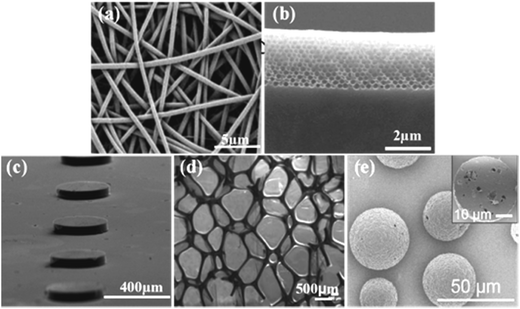 | ||
| Fig. 4 SMPs with various structures from the nanoscale to the macroscale. (a) Nanofibers. Reproduced with permission.81 Published under a CC-BY 4.0 license. Copyright 2015, the authors. (b) Thin porous films. Reproduced with permission.18 Published under a CC-BY 4.0 license. Copyright 2015, the authors. (c) Surface micropatterns on SMPs. Reproduced with permission.56 Copyright 2015, American Chemical Society. (d) Foams with different pore morphologies. Reproduced with permission.82 Copyright 2012, Wiley Periodicals, Inc. (e) Micro/nanoparticles. Reproduced with permission.53 Copyright 2013, Wiley-VHC. | ||
4.1 Shape memory nano/microfibers
Increasingly, practical applications of SMPs call for shape memory components fabricated in a variety of complex application-specific form factors. Traditionally, common fabrication methods have included injection molding and liquid molding, which can only produce simple shapes despite the relative complexity of the processes. Consequently, new manufacturing methods have emerged that are better suited to the application-specific needs of shape memory components.Electrospinning is a method to prepare nano/microfibers or particles by using a high-voltage electrostatic force. Compared with other methods to construct one-dimensional nano/micro materials, the electrospinning method is very simple, and the production efficiency is high, with excellent versatility. Therefore, in recent years, it has aroused widespread interest. Electrospinning is an established technique for the fabrication of organic or inorganic fibers with scales ranging from nanometers to micrometers and is well known as a method for preparing two dimensional (2D) and three dimensional (3D) fibrous structures.85–87 The advantages of this method include simplicity, speed, controllability, and compact size, and the ability to electrospin some polymers that do not show spinning properties into fibrous structures. Currently, more than 100 polymers have been electrospun into fibers, including many shape memory polymers, such as polyurethane, polycaprolactone, polylactic acid, Nafion, and chitosan/poly(ethylene oxide).88–90 In general, the ideal electrospun fibers have characteristics of a smooth surface, uniform diameter and round cross-section. Electrospun fibers can be designed with tunable secondary structures, which are usually obtained by adjusting the process parameters. SMPs and their composites can be electrospun into a variety of fibrous morphologies (Fig. 5), including non-woven fibers (Fig. 5a),91 oriented fibers (Fig. 5b),92 fibers with a core/shell structure (Fig. 5c),93 and fibers with a functional particle filling (Fig. 5d).94 Shape memory nano/microfibers show excellent shape memory performance and other specific properties by combining with some functional materials, being widely used in many fields. The adjustable high surface area and porosity of shape memory nano/microfibers can mimic the fibrillar nature of the extracellular matrix used in tissue engineering and provide more opportunities for immobilization of functional groups in diagnostics and other applications. In addition, compared to the traditional fibrous drug delivery system, shape memory nano/microfibers used in drug delivery systems can realize more precisely controlled drug release. The co-electrospinning technique further extends the method to a greater range of polymers that includes thermosetting polymers, which can be electrospun into fibers. Zhang et al. extended this method to make a co-electrospun core/shell structure fiber-based composite using polycaprolactone as the shell and epoxy as the core.93 Tuning of the individual properties of both components is possible with this approach, and adding epoxy enhanced the mechanical properties of the composite significantly. The resulting fibers exhibited excellent shape memory performance and have potential biomedical applications.45,95–97 In addition, electrospinning of SMPs with functional particle fillers can be used to achieve composite fibers with a multi-shape memory effect and rapid on-demand actuation by an external magnetic field.74,98 These properties are useful for some biomedical tissue scaffolds and drug release, and also demonstrate the potential value of such functional fillers. The different SMP nanofiber features are summarized in Table 1, including the shape recovery ratio Rr and shape fixing ratio Rf.
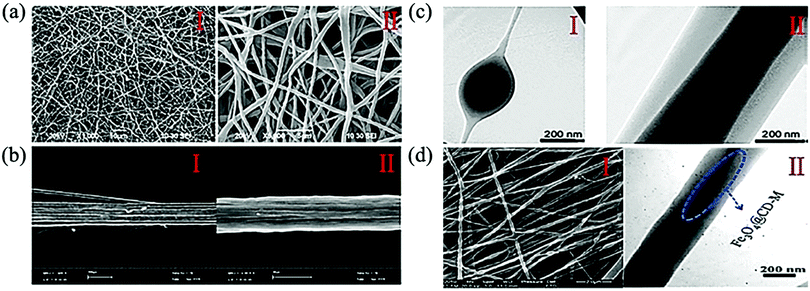 | ||
| Fig. 5 Electrospinning technology used with SMPs and their composites: (a) SEM image of SMPU nonwoven nanofibers formed by multi-electrospinning. Reproduced with permission.99 Copyright 2011, Springer. (b) SEM of SMF-3. View of multifilaments (500×). Reproduced with permission.92 Copyright 2011, IOP. (c) TEM images of (I) SMPU-PUPy53 and (II) TPUPUPyMDI35 core–shell nanofibers. Reproduced with permission.100 Copyright 2011, eXPRESS Polymer Letters. (d) TEM image of c-PCL/Fe3O4@CD-M electrospun composite fibers. Reproduced with permission.94 Copyright 2012, Elsevier. | ||
| Shape changing material | Driving condition | Fiber diameter | R r (%) | R f (%) | Application | Research team |
|---|---|---|---|---|---|---|
| Nafion | 130 °C heating | 200–400 nm | 92–94 | 88–92 | Scaffold fabrication | Zhang et al.90 |
| PCL, epoxy | 70 °C heating | 750–1200 nm | ≈100 | ≈100 | Smart structure | Zhang et al.93 |
| PCL, CNT, Fe3O4 | Magnetism | 300 nm | 90–92 | 75–84 | Tissue engineering | Gong et al.94 |
| PU | 40 °C heating | 100–500 nm | >95 | >92 | Wound healing | Tan et al.95 |
| Vinylbenzyl chloride (VBC) | UV iradiation | 500 nm | N/A | N/A | Controlled release | Fu et al.96 |
| PDLLA-co-TMC | 39 °C heating | 400–1800 nm | 94–98 | 98–99 | Tissue engineering | Bao et al.45 |
| PU | 37 °C heating | Nanoscale | 94–96 | 99–100 | Cell differentiation | Tseng et al.97 |
| Lignin | Moisture | Nanoscale | N/A | N/A | Actuator | Dallmeyer et al.101 |
| PLA, polypyrrole | Electricity 30 V | 1–15 μm | 98 | 98 | Actuator | Zhang et al.102 |
| Poly(ω-pentadecalactone) | 60 °C heating | 1.8–3.1 μm | 49–80 | 92–93 | Degradable material | Matsumoto et al.103 |
| Polyacrylonitrile (PAN) | Electricity 14 V | 200–600 nm | ≈100 | ≈100 | Remote control | Zhang et al.104 |
| PCL-PEG | Water | 810 ± 28 nm | 44–83 | 77–91 | Water sensor | Gu et al.105 |
| PCL | 25–55 °C water | 200–1000 μm | ≈100 | ≈100 | Actuator | Zhang et al.106 |
| Polyferrocenylmethylvinylsilane | Electricity 1.5–2 V | 2.0 ± 0.4 μm | N/A | N/A | Electric actuator | McDowell et al.107 |
| PCL, PEO | 55 °C heating | 3–10 μm | N/A | N/A | Tissue engineering | Yao et al.108 |
SMPs with fibrous structures have been particularly well-developed owing to their large surface areas, which allow for easy penetration and surface adsorption.95,96 Fibers and fibrous membranes are flexible and easily deformable and offer significant potential across a range of applications that call for an active structural/functional element. In the biomedical domain, shape memory nanofibers have served as scaffolds that provide a convenient and controllable substrate for cell growth.45 Typically, cells are cultured on a static surface; however, some research has demonstrated cell culture on fiber sheets with scaffolds that were programmed to change morphology during cell culture. For example, shape memory polyurethane fiber scaffolds have been used to test the hypothesis that a shape-memory-actuated change in fiber alignment can control the behavior and morphology of attached viable cells.97
4.2 4D printed nano/microstructures
A 4D printed polymer is a kind of material that can transform from one shape to another separate from the print bed. Printing technologies have been widely applied in the manufacture of 1D/2D/3D/4D prototypes and products.109–113 Additive manufacturing in the form of 3D printing is a process that enables the fabrication of complex 3D objects from digital data through selective 2D deposition of sequentially layered materials, effectively building up the final 3D object layer by layer from the microscale. The research of 4D printed SMPs with nano/microstructures focuses on the refined manufacturing of materials at the microscale and the corresponding shape memory effect. It is well known that regulated nano/micro dispersed structures bring good mechanical properties to the material. 4D printed microstructures enable the material to shift at the microscale, which is necessary for reversible actuators and biomedical devices. 4D printing has been used for the fabrication of various shape memory polymers including “active origami” features to realize self-folding or self-deployment functions.35,114 Moreover, selective deposition of functional fillers in defined regions of the polymer can be used to implement externally-stimulated shape actuation and recovery, facilitating remotely-triggered transformation into different 3D shapes.114 Recently, shape memory PCL has been printed into 2D and 3D shapes and has potential uses in a range of flexible and responsive electronic devices including wearable electronic devices, robotics, biomedical devices, and sensors. In addition, Qi et al. have taken additive manufacturing to the next level by successfully developing 4D printing, which adds the extra dimension of time to traditional 3D printing with potential applications in aerospace structures, biomedical devices, and robotics.36,115 Advances in manufacturing technology are spurring researchers to focus on 5D printing, which promises to meet application-specific needs by allowing printing of even more complex shapes. It is expected that advanced printing technologies from 1D to 4D, and even up to 5D or 6D, will lead to more opportunities for smart polymer-enabled products in the future (Fig. 6).4D printed nano/microstructures can be fabricated by fused deposition modeling (FDM) and stereolithography apparatus (SLA) techniques with a resolution of up to 1 μm,116 which allows for the formation of nano/microstructures such as scaffolds,117–122 honeybombs,123 and microballoons.124 4D printing allows the precise manipulation of structures on the macroscale. Nano/micro scaffold structures have been particularly widely studied, specifically in bioengineering, surgery, and tissue regeneration.125 4D printed microstructures are capable of promoting cell proliferation in desired arrangements.126 The 4D printed shape memory nano/microstructure can be compressed into a small volume, which can be transferred into a wound and then expand to the original shape under different shape recovery stimuli to refill the defect region. Cells can then be cultured on the scaffold as the porous structure gives cells enough space for growth and provides sufficient specific area for nutrient exchange. The shape recovery process significantly affects the mechanical behavior of the cells seeded on the scaffold. PCL and PU are the main SMPs used in 4D printed scaffold applications owing to their low Tg values, which can be adjusted to human body temperature. Hendrikson et al. fabricated a polyurethane scaffold with a glass transition temperature of ∼32 °C.117 The scaffold could be stretched up to 15% strain and recover the original shape under 37 °C. The cells seeded on the scaffold were elongated after shape recovery. Miao et al. adopted soybean oil epoxidized acrylate, which is a natural lipid, to fabricate a micropatterned scaffold using the SLA technique.120 The scaffolds showed excellent cell compatibility, and significantly improved the cardiomyogenic differentiation of stem cells. In a further study, a 4D printed neural scaffold was designed to induce stem cell differentiation during the self-morphing process.127 In addition to these applications, 4D nano/micro printing can also serve as an important method in other research areas. For example, Ge et al. fabricated a microgripper by 4D printing epoxy resin46 (Fig. 7a). Kuang et al. combined the self-healing technique with the 4D printing technique.123 Besides, the shape transition behavior of different deformable structures, for example, mesostructures, metamaterials, and 2D–3D transformation, has been reported128–130 (Fig. 7b–d).
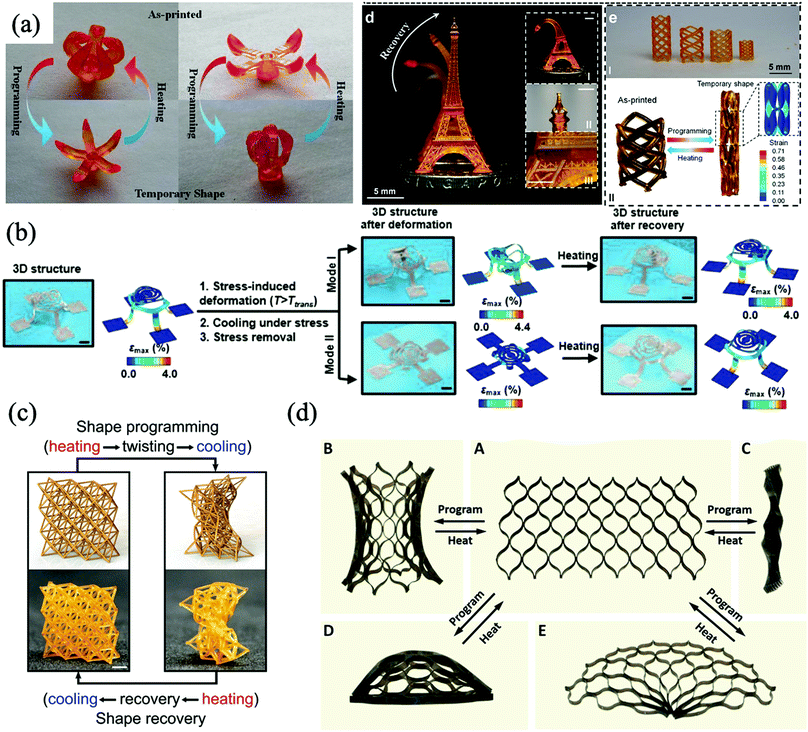 | ||
| Fig. 7 Different 4D printed SMP structures. (a) 4D printed SMP shape recovery process. Reproduced with permission.46 Published under a CC-BY 4.0 license. Copyright 2016, the authors. (b) 4D printed shape memory mesostructures. Reproduced with permission.128 Copyright 2019, Wiley-VHC. (c) 4D printed shape memory metamaterial. Reproduced with permission.129 Copyright 2019, The Royal Society of Chemistry. (d) 4D printed shape memory structure deformed from 2D to 3D. Reproduced with permission.130 Published under a CC-BY 4.0 license. Copyright 2017, the authors. | ||
4.3 Shape changing nano/microfoams
Foam is an important conformation that has a lot of tiny holes contained inside the matrix. The unique porous structure gives the foam unique properties for insulation and compressibility. The performance of SMP foams can be tuned according to actual requirements under the remote control of shape transforming at the microscale. SMPs in the form of porous foams differ from dense bulk SMPs, benefitting from properties such as low weight and volume, self-deployability, dynamic damping capabilities, high compression ratio, simplicity, and low cost.131,132 SMP foams can be fabricated using techniques such as gas blowing,133–137 salt leaching,49,138–140 freeze-drying,48,141,142 batch blowing,143–147 and microwave treatment14 (Table 2). The glass transition temperature and pore size can be tuned by using different foaming methods and chemical composites. The advantages of SMP foams—including their deployable structures—show particular promise for potential applications in biomedical and aerospace engineering. For example, in bioengineering, SMP foam is an effective filling device in the surgery used to treat aneurysms.148–150 In space applications, SMP foams can act as truss elements.151–153| Shape changing material | Driving condition | Pore diameter | Key feature | R r (%) | R f (%) | Application | Research team |
|---|---|---|---|---|---|---|---|
| PCL | 40 °C heating | 670 μm | Gas blowing | 91 | 94 | Bone regeneration | Xie et al.133 |
| PU | 37 °C heating | 40–200 μm | Gas blowing | 70 | N/A | Wound healing | Landsman et al.135 |
| PU | 37 °C heating | 534–797 μm | Gas blowing | 49–100 | 88–91 | Bone defect healing | Xie et al.136 |
| PU, epoxy | 100 °C heating | 750–1750 μm | Gas blowing | 90–99 | 70–95 | Engineering | Yao et al.137 |
| tert-Butyl acrylate (tBA) | 37 °C heating | 10 μm | Salt leaching | 80 | N/A | Cell seeding | Wang et al.138 |
| PU, urea | 60 °C heating | Microscale | Salt leaching | 85–99 | N/A | Biomedical devices | Chai et al.139 |
| PDMS, PCL | 55 °C heating | 200–450 μm | Salt leaching | 65–100 | ≈100 | Biomedical devices | Zhang et al.49 |
| Poly(vinyl alcohol)(PVA) | 50 °C heating | 60 μm | Freeze drying | 45.2–100.2 | 109–120 | Heat storage | Bonadies et al.141 |
| Epoxy | 55 °C heating | 50–300 μm | Freeze drying | >90 | >90 | Engineering | Dong et al.142 |
| Silicon | 107 °C heating | 10–100 nm | Freeze drying | 80 | N/A | Nanoscale foam | Galabura et al.48 |
| PU | 50 °C heating | 25–75 μm | Batch blowing | 67–80 | 99 | Environement friendly material | Madbouly et al.144 |
| 1,6-Hexanedithiol (HDT) | 100 °C heating | >1 μm | Batch blowing | 98 | 99.4 | Insulation materials | Michal et al.147 |
| PCL | Hot water, electric, microwave heating | ≈600 μm | Microwave | 87.7–99.2 | 43–98.7 | Tissue engineering | Zhang et al.14 |
| PU | 37 °C heating | 1000 μm | Gas blowing | N/A | N/A | Biomedical devices | Rodriguez et al.148 |
| Epoxy | 110 °C heating | ≈200 μm | Gas blowing | 72 | N/A | Aerospace engineering | Santo et al.151,153 |
| Epoxy/carbon nano fiber | 65 °C heating | 15–650 μm | Freeze drying | >90 | >90 | Engineering | Dong et al.159 |
| PU, short glass fiber | 80 °C heating | 100–200 μm | Gas blowing | 89–93 | 83.1–90.2 | Engineering | Kausar et al.161 |
| Epoxy, nano clay | 120 °C heating | Microscale | Gas blowing | >97 | N/A | Engineering | Quadrini et al.162 |
| Graphene, elastomer | >48 °C, or 6–10 V heating | ≈50 μm | Freeze drying | 50–99 | 99 | Engineering | Li et al.167 |
| Acrylate, methacrylate | 70 °C heating | 22–80 μm | Salt leaching | 52–98 | N/A | Engineering | Gurevitch et al.131 |
The pore diameter of SMP foams can be on the macro or nanoscale. The micropore size distribution has a significant effect on the shape recovery performance of the foams, and the foam density strongly influences the stress recovery properties.154 When the pore size is on the macro level and it forms a hierarchical structure, the SMP foam can revert to the original shape with a higher recovery rate compared with SMP foams with a smaller pore size and a homogeneous structure. To enhance bone ingrowth, a pore size above 100 μm was recommended.155 In addition, fast triggering of the shape recovery process is important in surgery. Xie et al. fabricated a polyurethane/hydroxyapatite based SMP foam with a pore size above 100 μm by polyol gas foaming133 (Fig. 8a). The foam was pre-compacted to seed in the bone defect, and recovered to the original shape in saline under 40 °C in 60 s. The SMP foam showed excellent biocompatibility for bone regeneration and facilitated tissue ingrowth and neovascularization. In addition to inserting into the defect area directly, the foam can be coated on a shape memory coil and then both can be transferred to the surgery area together.156–158
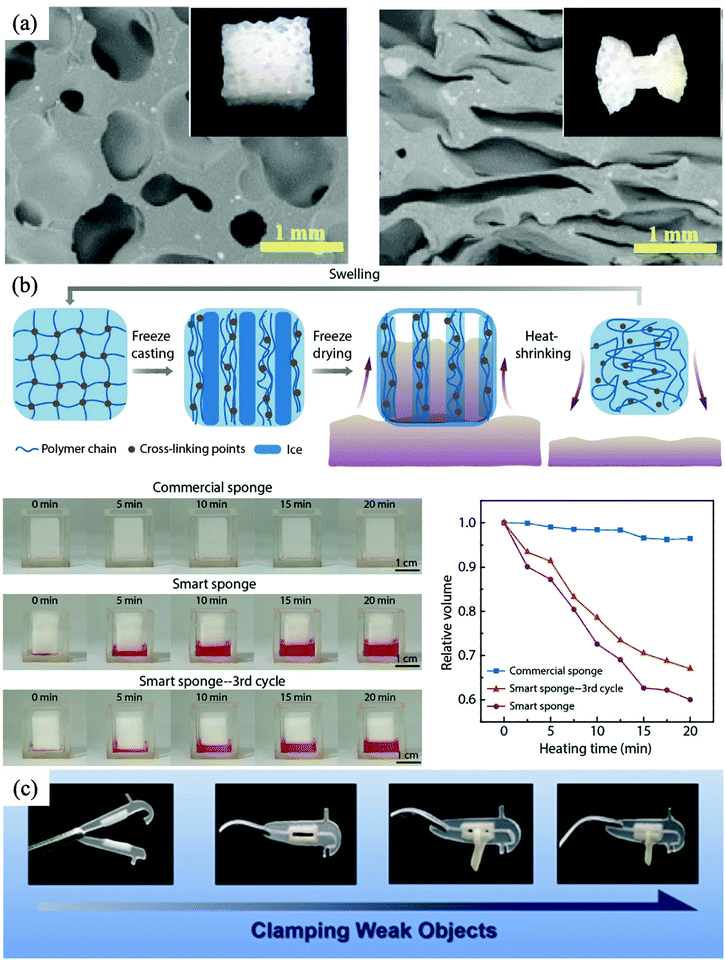 | ||
| Fig. 8 SMP foam structures. (a) SMP foam microstructure before and after being compressed. Reproduced with permission.133 Copyright 2018, Elsevier. (b) SMP smart foam with a thermo-responsive self-squezing property. Reproduced with permission.168 Copyright 2020, Wiley-VHC. (c) SMP clamping machine that can carry weak objects. Reproduced with permission.169 Copyright 2019, American Chemical Society. | ||
Different foaming methods have diverse effects on the micro/nanopore structure. In the gas foaming method, the foaming agent leads to cell aggregation and collapse if the polymer cures for a long period. In the leaching method, the pore size is dependent on the particle size used to make the salt templates and the amount of water used for leaching the salt will affect the interconnection of the foam. The leaching method and freeze-drying method can create a pore size below 10 μm without aggregation. Foams created by the leaching and freeze-drying methods have a more well-defined shape compared with foams synthesized using the gas blowing method. To fabricate foams with a pore size on the nanoscale, Galabura et al.48 demonstrated a foaming process that creates nanofoams using a freeze-drying method. When the nanofoam was heated to 107 °C, it contracted to reach 222 nm. The nanofoam was capable of producing gradual mechanical actuation at the nanoscale.
In addition to the foaming process, micro/nanofillers have an important impact on the properties of SMP foams. For example, Dong et al. combined a vapor growth carbon nanotube with an epoxy foam.159 The composite foam had a greater strength and a significantly higher conductivity, approaching 10 orders of magnitude higher than that of the pure epoxy foam. Hasan et al. incorporated aluminum oxide, silicon dioxide, and tungsten into SMP foams to tune the mechanical properties and thermal resistivity.160 Kausar et al. combined short glass fibers with polyurethane foam to improve the mechanical performance.161 Quadrini et al. combined montmorillonite with epoxy shape memory foam to improve the compressive toughness and stress relaxation.162 Piszczyk et al. blended graphene with polyurethane foam to improve the tensile strength and elongation.163 Pearson et al. combined alumina, Kevlar pulp, and PBO with polyurethane foam to improve the thermostability and the storage modulus.164 Liu et al. incorporated porous aluminum into polyurethane foam to achieve a high shape recovery ratio and a higher damping capacity.165
Other methods have also been used to enhance the properties of SMP foams. Fan et al. fabricated an SMP foam with a negative Poisson's ratio by steam treating.166 Fan and his group modified commercial shape memory foams with a closed-cell structure based on steam penetration and condensation processes. The micro re-entrant structure formed as a result of this process is the key to creating a negative Poisson's ratio. Li et al. fabricated a graphene oxide aerogel foam using a vacuum/air drying method.167 The uniform micro hexagon structure gave the aerogel foam a unique thermotropic shape memory performance, which resulted in excellent compressibility, a high fixing ratio, and an excellent recovery ratio. The graphene oxide foam also showed a low shape recovery actuation voltage of 6–10 V and a short recovery time of ∼8 s. Cui et al. developed a thermally induced self-squeezing sponge with a shape memory property. The smart sponge was capable of absorbing liquid rapidly with micro aligned hollow channels, and shrinking out the absorbed liquid during heating (Fig. 8b).168 In another study, Hou et al. constructed a clamping foam machine that can work under 50 °C (Fig. 8c).169 The features of a variety of SMP foams have been summarized in Table 2.
4.4 Smart nano/micropatterns
The surface nano/microstructures of polymer materials are closely related to the properties of materials. The nano/microstructures, combined with the vibrant and colorful characteristics of polymer materials, have essential scientific significance and application value in materials science, microelectronics and cell biology. SMP nano/micropatterns are uniformly distributed protrusion structures on the SMP surface. The addition of microstructure on SMP surfaces expands the range of potential applications for these unique materials. The molecular principle of SMPs does not vary with scale: micro and nanoscale SMP microstructures exhibit properties that are identical to those of macroscale bulk SMPs and enable a diverse range of innovative applications based on “smart surfaces” with switchable properties. SMP nano/micro array structures that are capable of optical wave-front shaping are implemented in optical waveguides and passive optical devices to alter the phase of the light propagating through them. This adjustable characteristic can be used in beam splitters, color rendering, anti-counterfeiting, filtering and other functional devices. SMPs with smart nano/micropatterns can be created by nanoindentation or replica molding. Instead of altering the surface chemistry, these processes change the surface topography, which results in SMPs having unique properties. Examples include wrinkled surfaces, surfaces with controlled wetting, reversible dry adhesives, and switchable information carriers (e.g. 2D barcodes), as well as surfaces with controllable and changeable optical behavior. The template method can adjust the shape, structure, size and arrangement of the surface by using the confinement of the template itself and the interaction between the template and the polymer. The construction of polymer surface nano/microstructures has developed from simple replication to various flexible applications, which can build three-dimensional multi-level and multi-scale micro nanostructures.SMP pillar arrays are common structures in smart nano/micropatterns.170–172 The pillars can be shaped as cylinders, cuboids, prisms, cones and polyhedra depending on the mold structure, and are on the macroscale with a dense arrangement on the SMP surface. Altering the arrangement and size of the pillar array significantly affects the topography of the SMP surface, which induces anisotropic liquid wetting. Above the glass transition temperature the pillars contract or tilt and revert to the original shape under stimulation. This process can lead to the smart controllability of the liquid. For example, Chen et al. investigated the wettability of SMP pillar arrays made with epoxy resin (Fig. 9a).173 The droplets on the surface adopted Wenzel state wetting in a static environment and were fully immobilized on the inclined surface. Chen and his group also described the behavior of droplets with the Cassie–Baxter model. Following the work of Chen and co-workers, Cheng et al. achieved the control of droplet motion on a hydrophobic surface.51 By controlling the SMP pillar shape recovery behavior on the microscale, Cheng and his group created a repeatable switch between superhydrophobic isotropic and anisotropic SMP pillar arrays. Controlling the tilt angle was the key factor in realizing this behavior. The distinct topography between the SMP pillars in different states induces the transportation of the droplets. In addition to controlling the movement, Lv et al. investigated an approach for fabricating an SMP pillar array with tunable adhesive superhydrophobicity.174 When the space between the pillars was greater than 20 μm, the SMP arrays showed low adhesion superhydrophobicity. High adhesion superhydrophobicity was achieved when a pit pillar structure was applied.
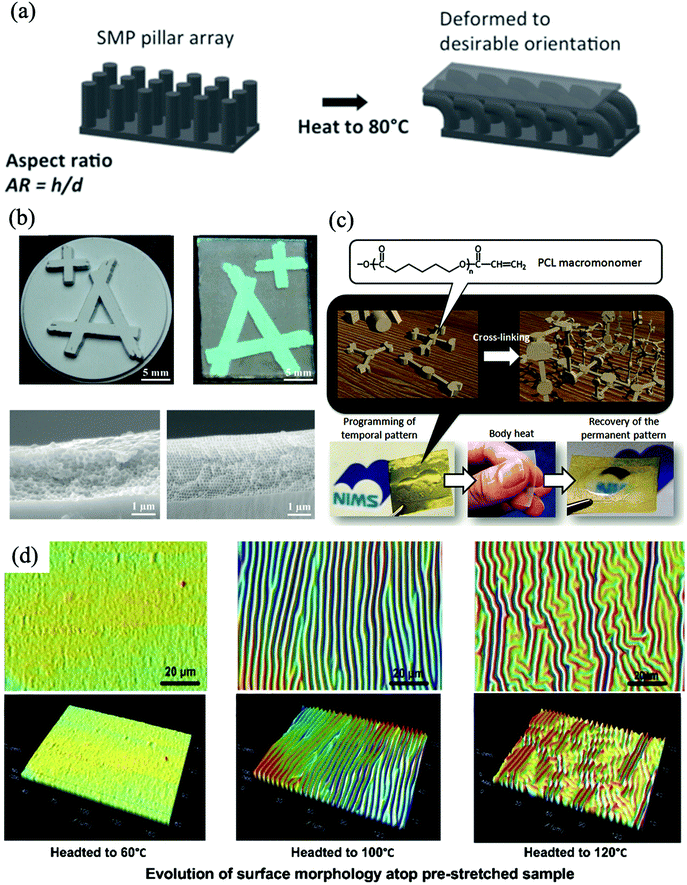 | ||
| Fig. 9 SMP patterns. (a) SMP pillar array. Reproduced with permission.173 Copyright 2014, Wiley-VHC. (b) SMP porous structure for control of the structure color. Reproduced with permission.50 Copyright 2015, The American Chemical Society. (c) SMP wrinkled surface for altering the transmittance. Reproduced with permission.52 Copyright 2012, Wiley-VHC. (d) SMP wrinkled surface for control of the structure color. Reproduced with permission.176 Copyright 2011, IOP. | ||
SMP porous surfaces are another important structure in smart nano/micropatterns. SMP porous surface structure can be fabricated by silica templating. The porous layer thickness and pore diameter affect the refraction and reflection of light. By controlling the structure deformation behavior, the color of SMP porous surfaces can be changed under different shape stimuli. Espinha et al. fabricated an SMP porous membrane that changed transparency under deformation175 as a result of the samples narrowing in the direction orthogonal to the stretching axis during elongation. Fang et al. investigated rewritable photonic patterns based on shape memory inverse opals (Fig. 9b).50 A porous multilayer structure with a diameter of approximately 200–400 nm was fabricated. Different micropatterns were written onto the SMP co-polymer membrane with a 1 mm diameter spherical sapphire tip.
In addition, wrinkled SMP surfaces can be fabricated by pressure indentation on SMP surfaces above the transition temperature with pre-stretching of the SMP, followed by surface metal coating. As the SMP recovers the original shape below a certain temperature, the metal contracts and forms a wrinkled structure. When the wavelength of these wrinkles is on the macroscale, structural color is exhibited at the surface of the material. Ebara et al. extended the wrinkle wavelength to the nanoscale, which created a wrinkle pattern that became transparent at human body temperature (Fig. 9c).52 Zhao et al. investigated the structural color of different wrinkle patterns on SMP surfaces (Fig. 9d).176 A 10-nm gold layer was coated on the polyurethane surface by sputter deposition. The result shows that the wrinkle degree strongly depends on the properties of the thin gold layer and the SMP substrate, which creates different wrinkle patterns. Different SMP pattern features are given in Table 3. The surface and interface are the windows to realize the function of devices and materials. The construction of surface nano/microstructures is of great significance to the performance of materials.
| Shape changing material | Driving condition | Minimum unit size | Key feature | Application | Research team |
|---|---|---|---|---|---|
| Epoxy | 80 °C heating | 10 μm | Replica molding | Microfluidic devices | Chen et al.173 |
| Epoxy | 120 °C heating | 10 μm | Replica molding | Microfluidic devices | Cheng et al.51 |
| Epoxy | 120 °C heating | 10 μm | Replica molding | Microreaction | Lv et al.174 |
| Poly(1,12-dodecanediol-co-citrate) | 30 °C heating | 140 ± 30 nm | Replica molding | Biophotonics | Romanov et al.175 |
| Polyethylene glycol (600) | Contact pressure | 200–400 nm | Molding | Rewritable data storage | Fang et al.50 |
| PS, PU | 80–100 °C heating | 700 nm | Sputter deposition | Wrinkle surfaces | Zhao et al.176 |
| PCL | 37 °C body heat | 300 nm | Nanopattern molding | Biomaterials | Ebara et al.52 |
| PS | 90 °C heating | 600 nm | Nano imprinting | Photonic devices | Li et al.177 |
| PEG-PCL | 35–41 °C heating | 10–15 μm | Micro imprinting | Vessel repair | Gong et al.178 |
4.5 Smart nano/microparticles
Nanoscale and microscale devices are increasingly required to support the trend towards miniaturization, for example, for use as switchable carriers for drug delivery or in brain surgery. As drug carriers, nano/microparticles have the advantages of high targeting, controlled drug release, and improved drug dissolution and absorption. The deformation performance of nano/microparticles is the same as that of macrostructured SMPs, which is determined by the SME of the material itself. Shape memory particles on the nanoscale and microscale have been reported over the past few years.78,169 Yang et al. presented the first example of shape memory nanoparticles with an intrinsic non-spherical shape.169 The fabricated nanoparticles were ellipsoidal in shape with high aspect ratio, and the shape could be controlled and manipulated by changing the underlying nematic order. The shape morphology and changing process are shown in Fig. 10a–d. Later, Wischke et al. prepared a kind of SMP microscale particle using an oil-in-water (o/w) emulsion technique as shown in Fig. 10e and f.78 In further research, crosslinked polyester microparticles were synthesized, and the corresponding shape recovery behavior was captured and analyzed with a microelectromechanical systems (MEMS) microgripper.179 The microscale particles could be activated on demand, switching between spherical and different predefined non-spherical shapes, which enabled the tailoring of the biodistribution and biorecognition in drug delivery.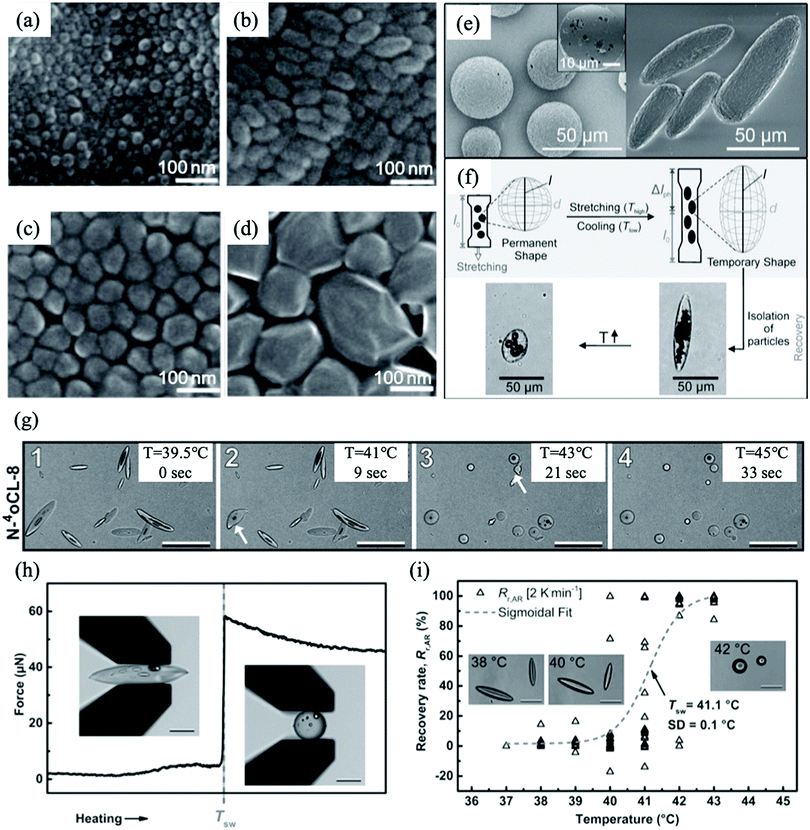 | ||
| Fig. 10 SMP particles, the apparent trend of the shape dependence on particle size confirms that seen in MCLCP: the F8BT nanoparticle shape changes from (a) spheres (30 nm) to (b) ellipsoids and back to (c) spheres (70 nm), the aspect ratio varies from 1.0 to 2.2 and back to 1.0 correspondingly; (d) irregular particles with size greater than 120 nm. Reproduced with permission.180 Copyright 2005, Nature Materials. (e) SEM images of particles in their permanent spherical shape (left) and programmed prolate ellipsoidal shape (right); (f) programming of spherical particles (permanent shape) embedded in PVA phantoms to their temporary shape, and microscopy of temperature-induced shape recovery for isolated particles. Reproduced with permission.53 Copyright 2013, Wiley-VHC. (g) Shape switching of polyester microparticles in an aqueous suspension. (h) Microparticles were captured and analyzed by a MEMS microgripper. (i) Analysis of the shape recovery rate for microparticles in an aqueous suspension. Reproduced with permission.179 Copyright 2014, Wiley-VHC. | ||
5. Applications
SMPs with the ability to change shape in response to external stimuli offer enormous promise and have attracted intense interest from researchers in many fields.5,8,26,109 Over the past few years, SMPs of various types have been researched and developed, some of which are now commercially available. In addition to their scientific appeal, such polymers have huge potential in fields as diverse as aerospace (e.g. self-deployable sun sails on spacecraft), automobiles (e.g. intelligent bumpers), medical devices (e.g. surgical implants; intelligent drug delivery and release), robotics, flexible electronic devices (e.g. flexible mobile phones), tactile user interfaces (e.g. smart braille keypads), information carriers (e.g. 2D barcodes), and smart textiles5,29,32,35,37,38 (Fig. 11). These examples represent only some of the potential opportunities, but regardless of the SMP type, structure, and size, cleverly designed SMPs promise superior performance for a wide range of practical applications.In the aerospace sector, SMPs and their composites are already well developed. An increasing number of deployable and morphing structures have been designed and tested, including deployable optical systems, trusses, hinges, deployable mirrors, booms, flexible reflectors, antennae, solar arrays, and morphing skins.5,29,30,110 In particular, SMP-based deployment devices can overcome some of the drawbacks of traditional deployable structures, notably the complex assembly processes and large sizes. Moreover, high-performance fiber reinforced SMP composites will increasingly replace traditional aerospace materials. A number of established finite element models have been developed to analyze the deformation and strain of the flexural or bending shell. It can be expected that SMPs and their composites will continue to deliver novel technologies that meet the challenging needs of the aerospace sector.
In addition to aerospace, recent development in smart polymer technologies is rapidly extending to reach other fields. SMPs in the form of fibers, yarns, and fabrics can be used to make smart textiles, clothing, and related products.32 SMP fibers with tunable shape and transition temperature can be used to make responsive clothing with superior elasticity and fit that spontaneously adjusts to the environment. In the biomedical space, biocompatible polymers, particularly polyurethane-based SMPs, have achieved excellent results and have been used in drug delivery systems, smart surgical sutures, and microactuators for blood clot removal, among other applications.28,37,38 In the automotive field, BMW is rethinking the design of automobile body shells, introducing non-metal materials to show a symbiotic relationship between materials, function, and aesthetics. SMPs offer a great deal of potential for such projects. Given the pace of innovation, SMPs will inevitably continue to play an important role in the development of new technologies for biomedical engineering. In addition to the chemical composition and macrostructure, the performance of the material surface depends largely on the nano/microstructure of the surface. The construction of polymer surface micro nanostructures has very important significance and application prospects in wettability regulation, thin surface optical performance enhancement, microfluidic transport and control, controlled drug release, preparation of tissue engineering materials and microelectronic devices, etc. Potential applications of smart polymers will also continue to expand in other areas. SMPs have been proposed for applications as diverse as airflow control, optical devices, self-healing devices, and self-folding/self-deployable devices.30,33,36,111,112
6. Conclusions and outlook
As archetypal smart materials, it is apparent that SMPs can have an impact on almost every aspect of our lives. However, there are also some problems to overcome in SMP materials, structures, properties and applications. Firstly, manufacturing technologies are necessary to be developed for making different forms so that the unique structures and properties of SMPs can be exploited from the nanoscale to the macroscale. Development in manufacturing technologies, notably 4D/5D printing technology, is simplifying the SMP production process and enabling accelerated fabrication of complex shapes and structures. In the future, SMP-based products will feature ever more in our daily lives and although SMPs are already available in a variety of forms, increasingly demanding applications call for continuous innovation. SMPs with new forms and functionality will continue to be required, for example, usability considerations lead to a need for SMPs with transition temperatures that are well matched to the particular application, while environmental considerations necessitate easily degradable “green materials” that minimize pollution. In addition, the ultimate goal is materials that are soft and flexible yet have variable stiffness, which is used for smart wearable devices and soft robotics. Most importantly, biodegradable and biocompatible SMPs with low transition temperature should be fabricated into nano or microstructures and realize remote actuation. In the biomedical sphere, SMPs and their composites show significant potential for use in tissue engineering and implanted organs that help to sustain and prolong life. Crucially, these fabrication technologies are integrating prior planning and programming of the shape memory functionality into the production process to realize SMP parts with tunable operation and remotely controlled actuation. Ultimately, it is possible to envisage soft robots with integrated sensors and actuators that can deform in response to external conditions, while still performing their predefined functions.Moreover, deep understanding of biological mechanisms should be investigated to make more stimulus-responsive SMPs for applications. The wide range of potential applications for SMPs is underpinned by their exotic characteristics, including the multiple shape memory effect, reversible response, selective stimulus-response, and programmable shape change. Significant inspiration could be gained from the study of similar biological systems in living organisms, such as morphing skins and structures that reconfigure themselves in response to their surroundings. A thorough understanding of the underlying biological mechanisms will bring insight to new stimulus-response technologies and their effective translation into engineered systems. SMPs offer a path to the practical realization of such complex multi-function structures and materials and chart a path towards the technologically advanced intelligent systems of the future. Based on the research of existing methods, how to construct polymer nano/microstructures on a smaller scale, with more extensive area and more accurately, and how to realize functional and intelligent polymer materials through multi-level nano/microstructures, will still be the challenges and opportunities in this field.
Conflicts of interest
There are no conflicts to declare.Acknowledgements
This work is funded by the National Natural Science Foundation of China (Grant No. 11632005, 11672086, 11802075). This work was also supported by the China Postdoctoral Science Foundation funded project.References
- R. Vaia and J. Baur, Science, 2008, 319, 420–421 CrossRef CAS PubMed.
- Y. Sun and Z. Guo, Nanoscale Horiz., 2019, 4, 52–76 RSC.
- D. A. Giannakoudakis, Y. Hu, M. Florent and T. J. Bandosz, Nanoscale Horiz., 2017, 2, 356–364 RSC.
- M. Ma, L. Guo, D. G. Anderson and R. Langer, Science, 2013, 339, 186–189 CrossRef CAS PubMed.
- R. M. Erb, J. S. Sander, R. Grisch and A. R. Studart, Nat. Commun., 2013, 4, 1712 CrossRef PubMed.
- C. S. Haines, M. D. Lima, N. Li, G. M. Spinks, J. Foroughi, J. D. W. Madden, S. H. Kim, S. Fang, M. Jung de Andrade, F. Göktepe, Ö. Göktepe, S. M. Mirvakili, S. Naficy, X. Lepró, J. Oh, M. E. Kozlov, S. J. Kim, X. Xu, B. J. Swedlove, G. G. Wallace and R. H. Baughman, Science, 2014, 343, 868 CrossRef CAS PubMed.
- J. Leng, X. Lan, Y. Liu and S. Du, Prog. Mater. Sci., 2011, 56, 1077–1135 CrossRef CAS.
- C. M. Yakacki, Polym. Rev., 2013, 53, 1–5 CrossRef CAS.
- J. J. McDowell, N. S. Zacharia, D. Puzzo, I. Manners and G. A. Ozin, J. Am. Chem. Soc., 2010, 132, 3236–3237 CrossRef CAS PubMed.
- H. Meng and G. Li, Polymer, 2013, 54, 2199–2221 CrossRef CAS.
- S. Chen, J. Hu, H. Zhuo, C. Yuen and L. Chan, Polymer, 2010, 51, 240–248 CrossRef CAS.
- A. Lendlein, H. Jiang, O. Jünger and R. Langer, Nature, 2005, 434, 879 CrossRef CAS PubMed.
- X. J. Han, Z. Q. Dong, M. M. Fan, Y. Liu, J. H. Li, Y. F. Wang, Q. J. Yuan, B. J. Li and S. Zhang, Macromol. Rapid Commun., 2012, 33, 1055–1060 CrossRef CAS PubMed.
- F. Zhang, T. Zhou, Y. Liu and J. Leng, Sci. Rep., 2015, 5, 11152 CrossRef.
- Y. Liu, H. Lv, X. Lan, J. Leng and S. Du, Compos. Sci. Technol., 2009, 69, 2064–2068 CrossRef CAS.
- M. Y. Razzaq, M. Behl and A. Lendlein, Adv. Funct. Mater., 2012, 22, 184–191 CrossRef CAS.
- W. M. Huang, B. Yang, L. An, C. Li and Y. S. Chan, Appl. Phys. Lett., 2005, 86, 114105 CrossRef.
- Y. Fang, Y. Ni, S.-Y. Leo, C. Taylor, V. Basile and P. Jiang, Nat. Commun., 2015, 6, 7416 CrossRef CAS.
- G. Li, G. Fei, H. Xia, J. Han and Y. Zhao, J. Mater. Chem., 2012, 22, 7692–7696 RSC.
- Y. Fang, Y. Ni, B. Choi, S. Y. Leo, J. Gao, B. Ge, C. Taylor, V. Basile and P. Jiang, Adv. Mater., 2015, 27, 3696–3704 CrossRef CAS PubMed.
- W. M. Huang, B. Yang, Y. Zhao and Z. Ding, J. Mater. Chem., 2010, 20, 3367–3381 RSC.
- Q. Zhao, H. J. Qi and T. Xie, Prog. Polym. Sci., 2015, 49-50, 79–120 CrossRef CAS.
- Q. Meng and J. Hu, Composites, Part A, 2009, 40, 1661–1672 CrossRef.
- A. Lendlein and R. Langer, Science, 2002, 296, 1673–1676 CrossRef PubMed.
- Y. Liu, H. Du, L. Liu and J. Leng, Smart Mater. Struct., 2014, 23 Search PubMed.
- W. M. Sokolowski and S. C. Tan, J. Spacecr. Rockets, 2007, 44, 750–754 CrossRef.
- A. Khaldi, C. Plesse, F. Vidal and S. K. Smoukov, Adv. Mater., 2015, 27, 4418–4422 CrossRef CAS PubMed.
- H. Jinlian, M. Harper, L. Guoqiang and I. I. Samuel, Smart Mater. Struct., 2012, 21, 053001 CrossRef.
- X. Luo and P. T. Mather, ACS Macro Lett., 2013, 2, 152–156 CrossRef CAS.
- H. Lu, W. Min Huang, X. Lian Wu, Y. Chun Ge, F. Zhang, Y. Zhao and J. Geng, Heating/ethanol-response of poly methyl methacrylate (PMMA) with gradient pre-deformation and potential temperature sensor and anti-counterfeit applications, 2014.
- T. Pretsch, M. Ecker, M. Schildhauer and M. Maskos, J. Mater. Chem., 2012, 22, 7757–7766 RSC.
- H. Xu, C. Yu, S. Wang, V. Malyarchuk, T. Xie and J. A. Rogers, Adv. Funct. Mater., 2013, 23, 3299–3306 CrossRef CAS.
- I. V. W. Small, P. Singhal, T. S. Wilson and D. J. Maitland, J. Mater. Chem., 2010, 20, 3356–3366 RSC.
- A. G. A. Coombes, S. C. Rizzi, M. Williamson, J. E. Barralet, S. Downes and W. A. Wallace, Biomaterials, 2004, 25, 315–325 CrossRef CAS.
- Y. Mao, K. Yu, M. S. Isakov, J. Wu, M. L. Dunn and H. Jerry Qi, Sci. Rep., 2015, 5, 13616 CrossRef PubMed.
- Q. Ge, H. J. Qi and M. L. Dunn, Appl. Phys. Lett., 2013, 103, 131901 CrossRef.
- A. S. Gladman, E. A. Matsumoto, R. G. Nuzzo, L. Mahadevan and J. A. Lewis, Nat. Mater., 2016, 15, 413–418 CrossRef PubMed.
- T. Chung, A. Romo-Uribe and P. T. Mather, Macromolecules, 2008, 41, 184–192 CrossRef CAS.
- Y. Wu, J. Hu, C. Zhang, J. Han, Y. Wang and B. Kumar, J. Mater. Chem. A, 2015, 3, 97–100 RSC.
- W. Li, Y. Liu and J. Leng, J. Mater. Chem. A, 2015, 3, 24532–24539 RSC.
- Z. Pei, Y. Yang, Q. Chen, Y. Wei and Y. Ji, Adv. Mater., 2016, 28, 156–160 CrossRef CAS PubMed.
- H. Koerner, G. Price, N. A. Pearce, M. Alexander and R. A. Vaia, Nat. Mater., 2004, 3, 115–120 CrossRef CAS PubMed.
- X. Luo and P. T. Mather, Adv. Funct. Mater., 2010, 20, 2649–2656 CrossRef CAS.
- M. D. Hager, S. Bode, C. Weber and U. S. Schubert, Prog. Polym. Sci., 2015, 49-50, 3–33 CrossRef CAS.
- M. Bao, X. Lou, Q. Zhou, W. Dong, H. Yuan and Y. Zhang, ACS Appl. Mater. Interfaces, 2014, 6, 2611–2621 CrossRef CAS PubMed.
- Q. Ge, A. H. Sakhaei, H. Lee, C. K. Dunn, N. X. Fang and M. L. Dunn, Sci. Rep., 2016, 6, 31110 CrossRef PubMed.
- H. Wei, Q. Zhang, Y. Yao, L. Liu, Y. Liu and J. Leng, ACS Appl. Mater. Interfaces, 2017, 9, 876–883 CrossRef CAS PubMed.
- Y. Galabura, A. P. Soliani, J. Giammarco, B. Zdyrko and I. Luzinov, Soft Matter, 2014, 10, 2567–2573 RSC.
- D. Zhang, K. M. Petersen and M. A. Grunlan, ACS Appl. Mater. Interfaces, 2013, 5, 186–191 CrossRef CAS PubMed.
- Y. Fang, Y. Ni, S. Y. Leo, B. Wang, V. Basile, C. Taylor and P. Jiang, ACS Appl. Mater. Interfaces, 2015, 7, 23650–23659 CrossRef CAS PubMed.
- Z. Cheng, D. Zhang, T. Lv, H. Lai, E. Zhang, H. Kang, Y. Wang, P. Liu, Y. Liu, Y. Du, S. Dou and L. Jiang, Adv. Funct. Mater., 2018, 28, 1705002 CrossRef.
- M. Ebara, K. Uto, N. Idota, J. M. Hoffman and T. Aoyagi, Adv. Mater., 2012, 24, 273–278 CrossRef CAS PubMed.
- C. Wischke, M. Schossig and A. Lendlein, Small, 2014, 10, 83–87 CrossRef CAS PubMed.
- A. Lendlein and S. Kelch, Angew. Chem., Int. Ed., 2002, 41, 2034–2057 CrossRef CAS.
- K. Yu, Q. Ge and H. J. Qi, Nat. Commun., 2014, 5, 3066 CrossRef.
- J. Wang, J. Li, N. Li, X. Guo, L. He, X. Cao, W. Zhang, R. He, Z. Qian, Y. Cao and Y. Chen, Chem. Mater., 2015, 27, 2439–2448 CrossRef CAS.
- T. Xie, Nature, 2010, 464, 267–270 CrossRef CAS PubMed.
- P. Miaudet, A. Derré, M. Maugey, C. Zakri, P. M. Piccione, R. Inoubli and P. Poulin, Science, 2007, 318, 1294 CrossRef CAS PubMed.
- Y. Bai, X. Zhang, Q. Wang and T. Wang, Shape memory property of microcrystalline cellulose–poly(ε-caprolactone) polymer network with broad transition temperature, 2014.
- J. Zotzmann, M. Behl, D. Hofmann and A. Lendlein, Adv. Mater., 2010, 22, 3424–3429 CrossRef CAS PubMed.
- R. M. Baker, J. H. Henderson and P. T. Mather, J. Mater. Chem. B, 2013, 1, 4916–4920 RSC.
- I. Kolesov, O. Dolynchuk, D. Jehnichen, U. Reuter, M. Stamm and H.-J. Radusch, Macromolecules, 2015, 48, 4438–4450 CrossRef CAS.
- S. Pandini, T. Riccò, A. Borboni, I. Bodini, D. Vetturi, D. Cambiaghi, M. Toselli, K. Paderni, M. Messori, F. Pilati, F. Chiellini and C. Bartoli, J. Mater. Eng. Perform., 2014, 23, 2545–2552 CrossRef CAS.
- C. A. Tippets, Q. Li, Y. Fu, E. U. Donev, J. Zhou, S. A. Turner, A.-M. S. Jackson, V. S. Ashby, S. S. Sheiko and R. Lopez, ACS Appl. Mater. Interfaces, 2015, 7, 14288–14293 CrossRef CAS PubMed.
- H. Lu, J. Gou, J. Leng and S. Du, Appl. Phys. Lett., 2011, 98, 174105 CrossRef.
- G. P. Tandon, K. Goecke, K. Cable and J. Baur, J. Intell. Mater. Syst. Struct., 2010, 21, 1365–1381 CrossRef CAS.
- L. Haibao, L. Fei, G. Jihua, L. Jinsong and D. Shanyi, Smart Mater. Struct., 2014, 23, 085034 CrossRef.
- M. Yoonessi, Y. Shi, D. A. Scheiman, M. Lebron-Colon, D. M. Tigelaar, R. A. Weiss and M. A. Meador, ACS Nano, 2012, 6, 7644–7655 CrossRef CAS PubMed.
- H. Du, Z. Song, J. Wang, Z. Liang, Y. Shen and F. You, Sens. Actuators, A, 2015, 228, 1–8 CrossRef CAS.
- L. Tan, L. Gan, J. Hu, Y. Zhu and J. Han, Composites, Part A, 2015, 76, 115–123 CrossRef CAS.
- K. Yu, Y. Liu and J. Leng, RSC Adv., 2014, 4, 2961–2968 RSC.
- U. N. Kumar, K. Kratz, M. Heuchel, M. Behl and A. Lendlein, Adv. Mater., 2011, 23, 4157–4162 CrossRef CAS PubMed.
- R. Mohr, K. Kratz, T. Weigel, M. Lucka-Gabor, M. Moneke and A. Lendlein, Proc. Natl. Acad. Sci. U. S. A., 2006, 103, 3540 CrossRef CAS PubMed.
- F. H. Zhang, Z. C. Zhang, C. J. Luo, I. T. Lin, Y. Liu, J. Leng and S. K. Smoukov, J. Mater. Chem. C, 2015, 3, 11290–11293 RSC.
- G. Li, Q. Yan, H. Xia and Y. Zhao, ACS Appl. Mater. Interfaces, 2015, 7, 12067–12073 CrossRef CAS PubMed.
- H. Lu, J. Leng and S. Du, Soft Matter, 2013, 9, 3851–3858 RSC.
- R. Xiao, J. Guo, D. L. Safranski and T. D. Nguyen, Soft Matter, 2015, 11, 3977–3985 RSC.
- W. Wang, H. Lu, Y. Liu and J. Leng, J. Mater. Chem. A, 2014, 2, 5441–5449 RSC.
- Z. He, N. Satarkar, T. Xie, Y.-T. Cheng and J. Z. Hilt, Adv. Mater., 2011, 23, 3192–3196 CrossRef CAS PubMed.
- Y. Wang, Y. Zhu, J. Huang, J. Cai, J. Zhu, X. Yang, J. Shen and C. Li, Nanoscale Horiz., 2017, 2, 225–232 RSC.
- S. Jiang, F. Liu, A. Lerch, L. Ionov and S. Agarwal, Adv. Mater., 2015, 27, 4865–4870 CrossRef CAS PubMed.
- P. Singhal, J. N. Rodriguez, W. Small, S. Eagleston, J. Van de Water, D. J. Maitland and T. S. Wilson, J. Polym. Sci., Part B: Polym. Phys., 2012, 50, 724–737 CrossRef CAS PubMed.
- D. Zhang, W. L. Burkes, C. A. Schoener and M. A. Grunlan, Polymer, 2012, 53, 2935–2941 CrossRef CAS.
- S. A. Bencherif, R. W. Sands, D. Bhatta, P. Arany, C. S. Verbeke, D. A. Edwards and D. J. Mooney, Proc. Natl. Acad. Sci. U. S. A., 2012, 109, 19590–19595 CrossRef CAS.
- D. Li and Y. Xia, Adv. Mater., 2004, 16, 1151–1170 CrossRef CAS.
- Z.-M. Huang, Y. Z. Zhang, M. Kotaki and S. Ramakrishna, Compos. Sci. Technol., 2003, 63, 2223–2253 CrossRef CAS.
- M. Hecht, B. Soberats, J. Zhu, V. Stepanenko, S. Agarwal, A. Greiner and F. Würthner, Nanoscale Horiz., 2019, 4, 169–174 RSC.
- D. I. Cha, H. Y. Kim, K. H. Lee, Y. C. Jung, J. W. Cho and B. C. Chun, J. Appl. Polym. Sci., 2005, 96, 460–465 CrossRef CAS.
- H. Zhuo, J. Hu and S. Chen, Mater. Lett., 2008, 62, 2074–2076 CrossRef.
- F. Zhang, Z. Zhang, Y. Liu and J. Leng, Fibers Polym., 2014, 15, 534–539 CrossRef CAS.
- H. Chen, X. Cao, J. Zhang, J. Zhang, Y. Ma, G. Shi, Y. Ke, D. Tong and L. Jiang, J. Mater. Chem., 2012, 22, 22387–22391 RSC.
- J. FengLong, Z. Yong, H. JinLian, L. Yan, Y. Lap-Yan and Y. GuangDou, Smart Mater. Struct., 2006, 15, 1547 CrossRef.
- F. Zhang, Z. Zhang, Y. Liu, W. Cheng, Y. Huang and J. Leng, Composites, Part A, 2015, 76, 54–61 CrossRef CAS.
- T. Gong, W. Li, H. Chen, L. Wang, S. Shao and S. Zhou, Acta Biomater., 2012, 8, 1248–1259 CrossRef CAS PubMed.
- L. Tan, J. Hu, H. Huang, J. Han and H. Hu, Int. J. Biol. Macromol., 2015, 79, 469–476 CrossRef CAS PubMed.
- G.-D. Fu, L.-Q. Xu, F. Yao, G.-L. Li and E.-T. Kang, ACS Appl. Mater. Interfaces, 2009, 1, 2424–2427 CrossRef CAS PubMed.
- L.-F. Tseng, P. T. Mather and J. H. Henderson, Acta Biomater., 2013, 9, 8790–8801 CrossRef CAS PubMed.
- F. Zhang, Z. Zhang, Y. Liu, H. Lu and J. Leng, Smart Mater. Struct., 2013, 22 Search PubMed.
- H. T. Zhuo, J. L. Hu and S. J. Chen, J. Mater. Sci., 2011, 46, 3464–3469 CrossRef CAS.
- H. T. Zhuo, J. L. Hu and S. J. Chen, eXPRESS Polym. Lett., 2011, 5, 182–187 CrossRef CAS.
- I. Dallmeyer, S. Chowdhury and J. F. Kadla, Biomacromolecules, 2013, 14, 2354–2363 CrossRef CAS.
- F. Zhang, Y. Xia, L. Wang, L. Liu, Y. Liu and J. Leng, ACS Appl. Mater. Interfaces, 2018, 10(41), 35526–35532, DOI:10.1021/acsami.8b12743.
- H. Matsumoto, T. Ishiguro, Y. Konosu, M. Minagawa, A. Tanioka, K. Richau, K. Kratz and A. Lendlein, Eur. Polym. J., 2012, 48, 1866–1874 CrossRef CAS.
- F. Zhang, Z. Zhang, Y. Liu and J. Leng, Smart Mater. Struct., 2014, 23, 065020 CrossRef.
- X. Z. Gu and P. T. Mather, RSC Adv., 2013, 3, 15783–15791 RSC.
- J. N. Zhang, Y. M. Ma, J. J. Zhang, D. Xu, Q. L. Yang, J. G. Guan, X. Y. Cao and L. Jiang, Mater. Lett., 2011, 65, 3639–3642 CrossRef CAS.
- J. J. McDowell, N. S. Zacharia, D. Puzzo, I. Manners and G. A. Ozin, J. Am. Chem. Soc., 2010, 132, 3236–3237 CrossRef CAS PubMed.
- Y. T. Yao, H. Q. Wei, J. J. Wang, H. B. Lu, J. S. Leng and D. Hui, Composites, Part B, 2015, 83, 264–269 CrossRef CAS.
- H. Wei, Q. Zhang, Y. Yao, L. Liu, Y. Liu and J. Leng, ACS Appl. Mater. Interfaces, 2017, 9, 876–883 CrossRef CAS PubMed.
- F. Momeni, S. M. Mehdi Hassani.N, X. Liu and J. Ni, Mater. Des., 2017, 122, 42–79 CrossRef CAS.
- S. Tibbits, Archit. Des., 2014, 84, 116–121 Search PubMed.
- Y. Zhang, L. Shi, D. Hu, S. Chen, S. Xie, Y. Lu, Y. Cao, Z. Zhu, L. Jin, B.-O. Guan, S. Rogge and X. Li, Nanoscale Horiz., 2019, 4, 601–609 RSC.
- S. Deng, J. Wu, M. D. Dickey, Q. Zhao and T. Xie, Adv. Mater., 2019, 31, 1903970 CrossRef PubMed.
- K. Yu, A. Ritchie, Y. Mao, M. L. Dunn and H. J. Qi, Procedia IUTAM, 2015, 12, 193–203 CrossRef.
- Q. Ge, C. K. Dunn, H. J. Qi and M. L. Dunn, Smart Mater. Struct., 2014, 23 Search PubMed.
- C. Sun, N. Fang, D. M. Wu and X. Zhang, Sens. Actuators, A, 2005, 121, 113–120 CrossRef CAS.
- W. J. Hendrikson, J. Rouwkema, F. Clementi, C. A. van Blitterswijk, S. Fare and L. Moroni, Biofabrication, 2017, 9, 031001 CrossRef.
- W. J. Hendrikson, J. Rouwkema, C. A. van Blitterswijk and L. Moroni, RSC Adv., 2015, 5, 54510–54516 RSC.
- S. Miao, W. Zhu, N. J. Castro, M. Nowicki, X. Zhou, H. Cui, J. P. Fisher and L. G. Zhang, Sci. Rep., 2016, 6, 27226 CrossRef CAS.
- S. Miao, H. Cui, M. Nowicki, S.-J. Lee, J. Almeida, X. Zhou, W. Zhu, X. Yao, F. Masood, M. W. Plesniak, M. Mohiuddin and L. G. Zhang, Biofabrication, 2018, 10 Search PubMed.
- S. Sharifi, S. Blanquer and D. W. Grijpma, J. Appl. Biomater. Funct. Mater., 2012, 10, 280–286 CAS.
- B. Zhang, J. D. Skelly, J. R. Maalouf, D. C. Ayers and J. Song, Sci. Transl. Med., 2019, 11, eaau7411 CrossRef PubMed.
- X. Kuang, K. Chen, C. K. Dunn, J. Wu, V. C. F. Li and H. J. Qi, ACS Appl. Mater. Interfaces, 2018, 10, 7381–7388 CrossRef CAS PubMed.
- A. S. Wu, W. Small Iv, T. M. Bryson, E. Cheng, T. R. Metz, S. E. Schulze, E. B. Duoss and T. S. Wilson, Sci. Rep., 2017, 7, 4664 CrossRef PubMed.
- C. Lin, J. Lv, Y. Li, F. Zhang, J. Li, Y. Liu, L. Liu and J. Leng, Adv. Funct. Mater., 2019, 29, 1906569 CrossRef CAS.
- D. Liu, T. Xiang, T. Gong, T. Tian, X. Liu and S. Zhou, ACS Appl. Mater. Interfaces, 2017, 9, 19725–19735 CrossRef CAS PubMed.
- S. Miao, H. Cui, T. Esworthy, B. Mahadik, S.-J. Lee, X. Zhou, S. Y. Hann, J. P. Fisher and L. G. Zhang, Adv. Sci., 2020, 7, 1902403 CrossRef CAS PubMed.
- X. Wang, X. Guo, J. Ye, N. Zheng, P. Kohli, D. Choi, Y. Zhang, Z. Xie, Q. Zhang, H. Luan, K. Nan, B. H. Kim, Y. Xu, X. Shan, W. Bai, R. Sun, Z. Wang, H. Jang, F. Zhang, Y. Ma, Z. Xu, X. Feng, T. Xie, Y. Huang, Y. Zhang and J. A. Rogers, Adv. Mater., 2019, 31, 1805615 CrossRef PubMed.
- C. Yang, M. Boorugu, A. Dopp, J. Ren, R. Martin, D. Han, W. Choi and H. Lee, Mater. Horiz., 2019, 6, 1244–1250 RSC.
- Z. Ding, C. Yuan, X. Peng, T. Wang, H. J. Qi and M. L. Dunn, Sci. Adv., 2017, 3, e1602890 CrossRef.
- I. Gurevitch and M. S. Silverstein, Soft Matter, 2012, 8 Search PubMed.
- D. Khedaioui, C. Boisson, F. D'Agosto and D. Montarnal, Angew. Chem., Int. Ed., 2019, 58, 15883–15889 CrossRef CAS PubMed.
- R. Xie, J. Hu, O. Hoffmann, Y. Zhang, F. Ng, T. Qin and X. Guo, Biochim. Biophys. Acta, Gen. Subj., 2018, 1862, 936–945 CrossRef CAS PubMed.
- S. M. Kang, S. J. Lee and B. K. Kim, eXPRESS Polym. Lett., 2012, 6, 63–69 CrossRef CAS.
- T. L. Landsman, T. Touchet, S. M. Hasan, C. Smith, B. Russell, J. Rivera, D. J. Maitland and E. Cosgriff-Hernandez, Acta Biomater., 2017, 47, 91–99 CrossRef CAS.
- R. Xie, J. Hu, F. Ng, L. Tan, T. Qin, M. Zhang and X. Guo, Ceram. Int., 2017, 43, 4794–4802 CrossRef CAS.
- Y. Yao, T. Zhou, C. Yang, Y. Liu and J. Leng, Smart Mater. Struct., 2016, 25 Search PubMed.
- J. Wang, M. E. Brasch, R. M. Baker, L. F. Tseng, A. N. Pena and J. H. Henderson, J. Mater. Sci.: Mater. Med., 2017, 28, 151 CrossRef PubMed.
- Q. Chai, Y. Huang, T. L. Kirley and N. Ayres, Polym. Chem., 2017, 8, 5039–5048 RSC.
- J. D. Erndt-Marino, D. J. Munoz-Pinto, S. Samavedi, A. C. Jimenez-Vergara, P. Diaz-Rodriguez, L. Woodard, D. Zhang, M. A. Grunlan and M. S. Hahn, ACS Biomater. Sci. Eng., 2015, 1, 1220–1230 CrossRef CAS.
- I. Bonadies, A. Izzo Renzi, M. Cocca, M. Avella, C. Carfagna and P. Persico, Ind. Eng. Chem. Res., 2015, 54, 9342–9350 CrossRef CAS.
- Y. Dong, Y. Fu and Q.-Q. Ni, J. Appl. Polym. Sci., 2015, 132, 42599 Search PubMed.
- M. Karimi, M. Heuchel, T. Weigel, M. Schossig, D. Hofmann and A. Lendlein, J. Supercrit. Fluids, 2012, 61, 175–190 CrossRef CAS.
- S. A. Madbouly and A. Lendlein, Macromol. Mater. Eng., 2012, 297, 1213–1224 CrossRef CAS.
- L. Meng, H. Liu, L. Yu, S. Khalid, L. Chen, T. Jiang and Q. Li, J. Appl. Polym. Sci., 2017, 134 Search PubMed.
- H.-Y. Mi, X. Jing, M. R. Salick, X.-F. Peng and L.-S. Turng, Polym. Eng. Sci., 2014, 54, 2947–2957 CrossRef CAS.
- B. T. Michal, W. A. Brenn, B. N. Nguyen, L. S. McCorkle, M. A. B. Meador and S. J. Rowan, Chem. Mater., 2016, 28, 2341–2347 CrossRef CAS.
- J. N. Rodriguez, M. W. Miller, A. Boyle, J. Horn, C. K. Yang, T. S. Wilson, J. M. Ortega, W. Small, L. Nash, H. Skoog and D. J. Maitland, J. Mech. Behav. Biomed. Mater., 2014, 40, 102–114 CrossRef CAS PubMed.
- J. N. Rodriguez, Y. J. Yu, M. W. Miller, T. S. Wilson, J. Hartman, F. J. Clubb, B. Gentry and D. J. Maitland, Ann. Biomed. Eng., 2012, 40, 883–897 CrossRef PubMed.
- J. M. Ortega, J. Hartman, J. N. Rodriguez and D. J. Maitland, Ann. Biomed. Eng., 2013, 41, 725–743 CrossRef CAS.
- L. Santo, F. Quadrini, G. Mascetti, F. Dolce and V. Zolesi, Acta Astronaut., 2013, 91, 333–340 CrossRef CAS.
- Q. Fabrizio, S. Loredana and S. E. Anna, Mater. Lett., 2012, 69, 20–23 CrossRef CAS.
- L. Santo, F. Quadrini, W. Villadei, G. Mascetti and V. Zolesi, Procedia Eng., 2015, 104, 50–56 CrossRef CAS.
- T. Sauter, K. Kratz and A. Lendlein, Macromol. Chem. Phys., 2013, 214, 1184–1188 CrossRef CAS.
- A. C. Jones, C. H. Arns, A. P. Sheppard, D. W. Hutmacher, B. K. Milthorpe and M. A. Knackstedt, Biomaterials, 2007, 28, 2491–2504 CrossRef CAS.
- A. J. Boyle, T. L. Landsman, M. A. Wierzbicki, L. D. Nash, W. Hwang, M. W. Miller, E. Tuzun, S. M. Hasan and D. J. Maitland, J. Biomed. Mater. Res., Part B, 2016, 104, 1407–1415 CrossRef CAS PubMed.
- A. J. Boyle, M. A. Wierzbicki, S. Herting, A. C. Weems, A. Nathan, W. Hwang and D. J. Maitland, Med. Eng. Phys., 2017, 49, 56–62 CrossRef PubMed.
- J. Horn, W. Hwang, S. L. Jessen, B. K. Keller, M. W. Miller, E. Tuzun, J. Hartman, F. J. Clubb, Jr. and D. J. Maitland, J. Biomed. Mater. Res., Part B, 2017, 105, 1892–1905 CrossRef CAS PubMed.
- Y. Dong, J. Ding, J. Wang, X. Fu, H. Hu, S. Li, H. Yang, C. Xu, M. Du and Y. Fu, Compos. Sci. Technol., 2013, 76, 8–13 CrossRef CAS.
- S. M. Hasan, R. S. Thompson, H. Emery, A. L. Nathan, A. C. Weems, F. Zhou, M. B. Monroe and D. J. Maitland, RSC Adv., 2016, 6, 918–927 RSC.
- A. Kausar, J. Polym. Eng., 2018, 38, 33–40 CAS.
- F. Quadrini, L. Santo and E. A. Squeo, Polym.-Plast. Technol. Eng., 2012, 51, 560–567 CrossRef CAS.
- Ł. Piszczyk, M. Strankowski and P. Kosmela, Polym. Compos., 2017, 38, 2248–2253 CrossRef.
- A. Pearson and H. E. Naguib, Composites, Part B, 2017, 122, 192–201 CrossRef CAS.
- S. Liu, A. Li, S. He and P. Xuan, Composites, Part A, 2015, 78, 35–41 CAS.
- D. Fan, M. Li, J. Qiu, H. Xing, Z. Jiang and T. Tang, ACS Appl. Mater. Interfaces, 2018, 10, 22669–22677 CrossRef CAS PubMed.
- C. Li, L. Qiu, B. Zhang, D. Li and C. Y. Liu, Adv. Mater., 2016, 28, 1510–1516 CrossRef CAS PubMed.
- Y. Cui, Y. Wang, Z. Shao, A. Mao, W. Gao and H. Bai, Adv. Mater., 2020, 32, 1908249 CrossRef CAS PubMed.
- Y. Hou, G. Fang, Y. Jiang, H. Song, Y. Zhang and Q. Zhao, ACS Appl. Mater. Interfaces, 2019, 11, 32423–32430 CrossRef CAS PubMed.
- C. Li, Y. Jiao, X. Lv, S. Wu, C. Chen, Y. Zhang, J. Li, Y. Hu, D. Wu and J. Chu, ACS Appl. Mater. Interfaces, 2020, 12, 13464–13472 CrossRef PubMed.
- H.-Y. Tseng, Y.-H. Chen, R.-Y. Chen and H. Yang, ACS Appl. Mater. Interfaces, 2020, 12, 10883–10892 CrossRef PubMed.
- Y. Liu, M. Y. Razzaq, T. Rudolph, L. Fang, K. Kratz and A. Lendlein, Macromolecules, 2017, 50, 2518–2527 CrossRef CAS.
- C. M. Chen and S. Yang, Adv. Mater., 2014, 26, 1283–1288 CrossRef CAS PubMed.
- T. Lv, Z. Cheng, D. Zhang, E. Zhang, Q. Zhao, Y. Liu and L. Jiang, ACS Nano, 2016, 10(10), 9379–9386, DOI:10.1021/acsnano.6b04257.
- S. G. Romanov, G. Lozano, D. Gerace, C. Monat, H. R. Míguez, A. Espinha, M. Concepción Serrano, Á. Blanco and C. López, presented in part at the Photonic Crystal Materials and Devices XI, 2014.
- Y. Zhao, W. M. Huang and Y. Q. Fu, J. Micromech. Microeng., 2011, 21, 067007 CrossRef.
- P. Li, Y. Han, W. Wang, Y. Liu, P. Jin and J. Leng, Sci. Rep., 2017, 7, 44333 CrossRef PubMed.
- T. Gong, K. Zhao, X. Liu, L. Lu, D. Liu and S. Zhou, Small, 2016, 12, 5769–5778 CrossRef CAS PubMed.
- F. Friess, U. Nöchel, A. Lendlein and C. Wischke, Adv. Healthcare Mater., 2014, 3, 1986–1990 CrossRef CAS PubMed.
- Z. Yang, W. T. Huck, S. M. Clarke, A. R. Tajbakhsh and E. M. Terentjev, Nat. Mater., 2005, 4, 486–490 CrossRef CAS.
| This journal is © The Royal Society of Chemistry 2020 |



